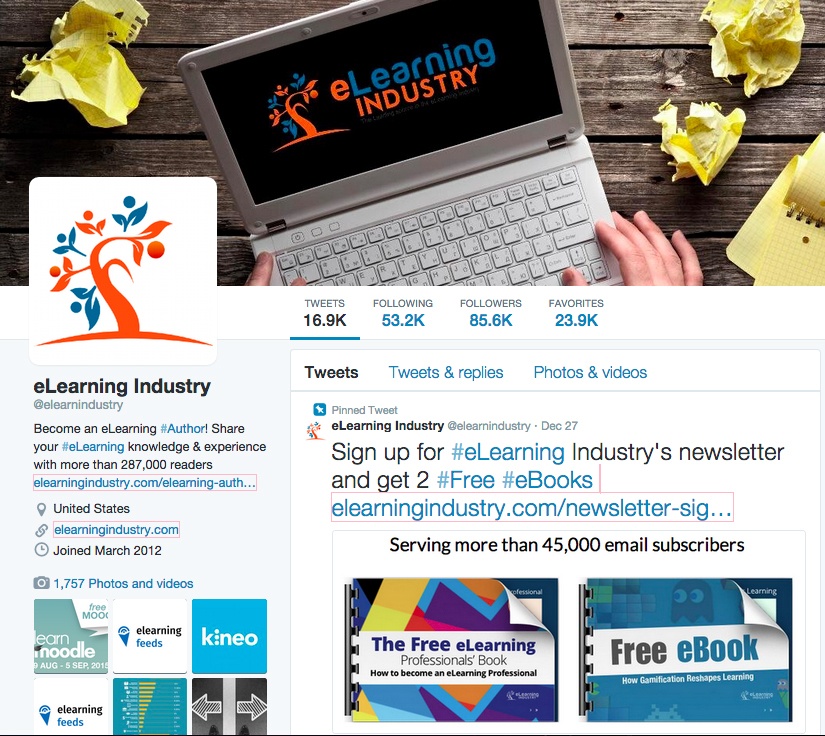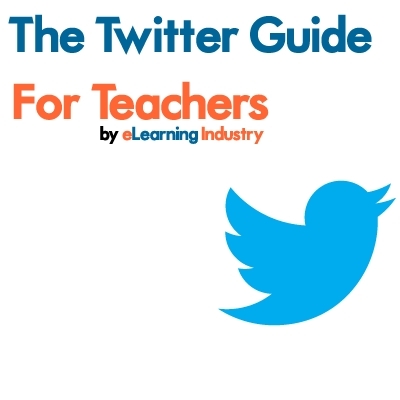How To Use Twitter For eLearning: What eLearning Professionals Should Know
Twitter, as a popular social network, can be used in various ways for social learning, as it offers many benefits when it comes to reaching your audience. But is it the right social media solution for you? In this article, I'll give you tips on factors to consider when evaluating Twitter for eLearning use, in order to determine whether incorporating it into your eLearning strategy is worth the effort or not. If you haven’t yet, follow @elearnindustry to keep up with what we’re doing, working on, and seeing great sources focused on eLearning.
Using Twitter For eLearning: Strong Points
- It is easy to use and highly interactive.
Hashtags (#) can be used in various ways, all of which being effective: you can use a hashtag to communicate directly with your learners and clients and address their concerns, to draw attention to the subject matter and encourage your audience to ask questions or follow the subject matter expert or simply to tag your eLearning course in order to gather all the relevant information. Furthermore, using hashtags will help you search all tweets and take a look at all keywords that interest you. - It is accessible from anywhere.
With Twitter apps available for all mobile devices, tablets and platforms, you can be sure that your tweets reach your learners and clients whenever and wherever they are. - It is ideal for micro-eLearning.
Twitter posts’ 140 character limit forces you to apply the essence of micro-eLearning: concise and impactful. With only 140 characters you must deliver a message that gets to the point. When done right, an eLearning tweet becomes easy to remember, provokes a reaction and initiates discussion. - It provides opportunities for real time discussion.
Using Twitter for live micro-blogging is probably the biggest advantage of Twitter. Posting during an eLearning event or lecture fosters online discussion among your followers, learners and clients at the exact moment, and it can be used for further discussion later, in the virtual classroom. - It is great for connecting with your younger audience.
A big percentage of Twitter users are under the age of 29, which means that you can easily reach not only your younger audience through this social medium, but also the next generation of your customers. Furthermore, Twitter is a great tool for discovering the latest information and eLearning trends, as well as many fresh ideas. - It is a powerful tool for eLearning professionals networking.
Twitter is a great place not only for connecting with your audience and clients, but also for meeting potential partners. Sharing your latest eLearning articles or achievements, connecting with experts and other organizations instantly, finding ideas for future eLearning techniques, promoting your products; you can do all these and a lot more just with the touch of your finger and in less than a minute. - It can be used to acquire eLearning feedback.
Because Twitter is so easy to use and encourages instant and direct communication, encouraging your audience to comment on their eLearning experience can provide you with the opportunity to collect valuable feedback about the effectiveness of your eLearning course. This way, you will be able to evaluate your eLearning course and make the necessary adjustments and improvements. - It can build a strong community among your learners.
Encourage your audience to use this social network platform to share their thoughts, interests, and concerns. Reflecting on what they are learning and sharing it with others will help them to communicate and collaborate with their peers and it will provide you with a priceless tool for social learning.
Using Twitter For eLearning: Weak Points
- It limits you to 140 characters.
Micro-eLearning is great, but the limit of 140 characters on Twitter can be proven a real challenge. It might be difficult for you to express your thoughts effectively in so few words. You may need to restrict yourself to a “word of the day” kind of posts, and sometimes this is not enough. - Tweets may be considered as just moments in time.
Twitter streams really quickly and shows the latest posts. This might be a problem when you want to post more than one important tweets in a row, as your learners will find it difficult to keep track among the hundreds of Twitter users they follow. - It sends direct messages only to one user at a time.
While this is probably a Twitter strategy to prevent spammers from taking advantage of the platform, the restriction of sending direct messages to only one user at a time could be proven inefficient when you want to use one of your learner’s comment to make a point for your entire audience. - It is not the ideal medium for visual content.
Despite being able to post images on Twitter, it is mostly text-based and it doesn’t allow you to post more than one picture at a time, let alone videos; you can only add links to YouTube. Keep in mind that visual content engages your audience much more than text. - It can be distracting.
Twitter cannot only be time consuming for you, after all, interacting with followers, scheduling posts and creating an effective 140 character message cannot be done automatically, but also in some cases, it may distract your audience. As it usually happens when wandering around in social media, valuable time is likely to be lost, which can negatively influence productivity. - It doesn’t archive content and conversations.
While Twitter can be a great platform for in-depth online discussion when used properly, it is impossible for one to review an entire dialogue exchange as this social medium doesn’t offer you the ability to thread your conversations.
Now that you know how to evaluate Twitter for eLearning, you may want to know how you can benefit from other social networking platforms, such as Google Plus. Read the article 7 Tips To Use Google Plus For Social Learning and find out how you can turn your eLearning course into a more interactive and collaborative experience for your learners.







